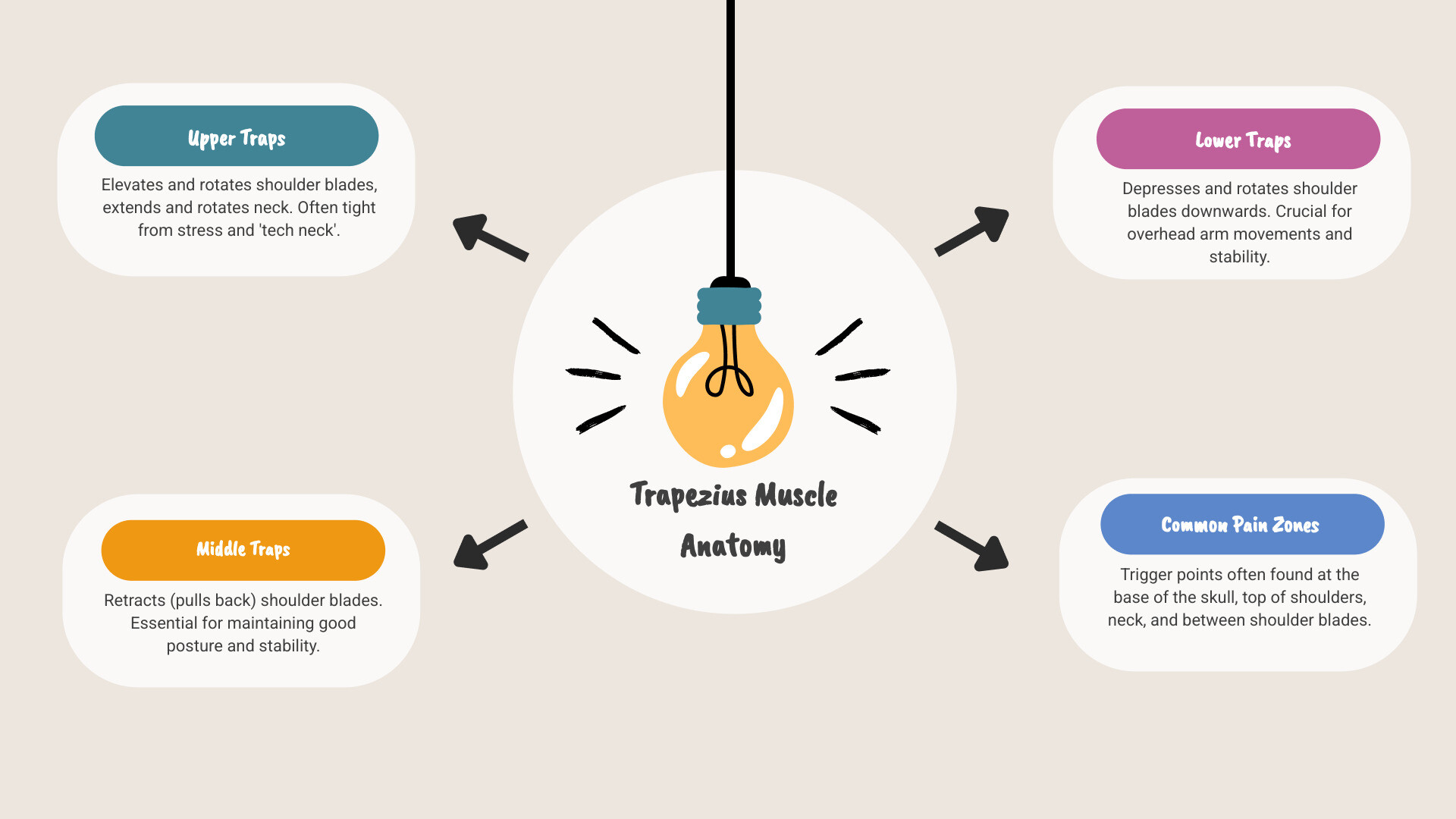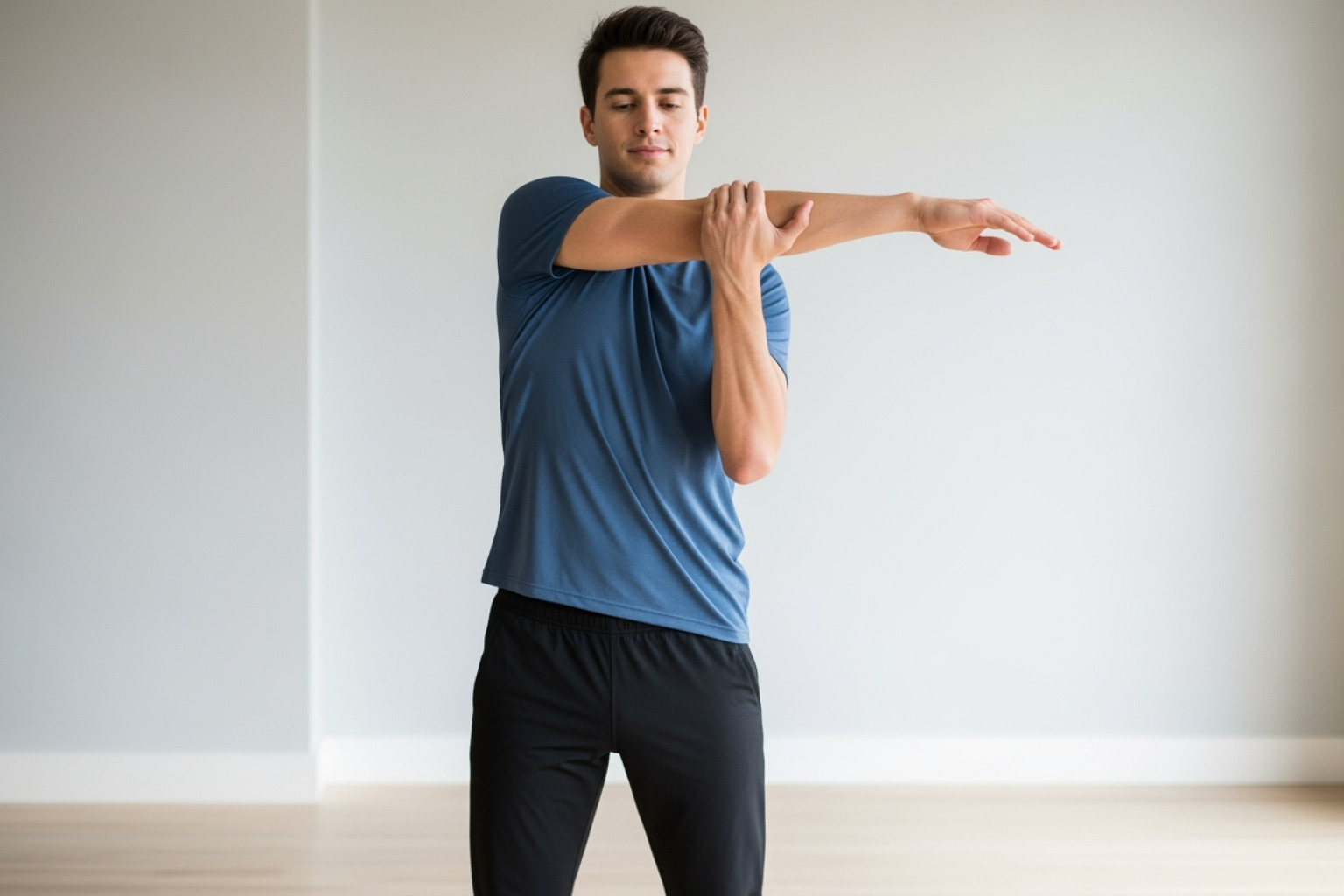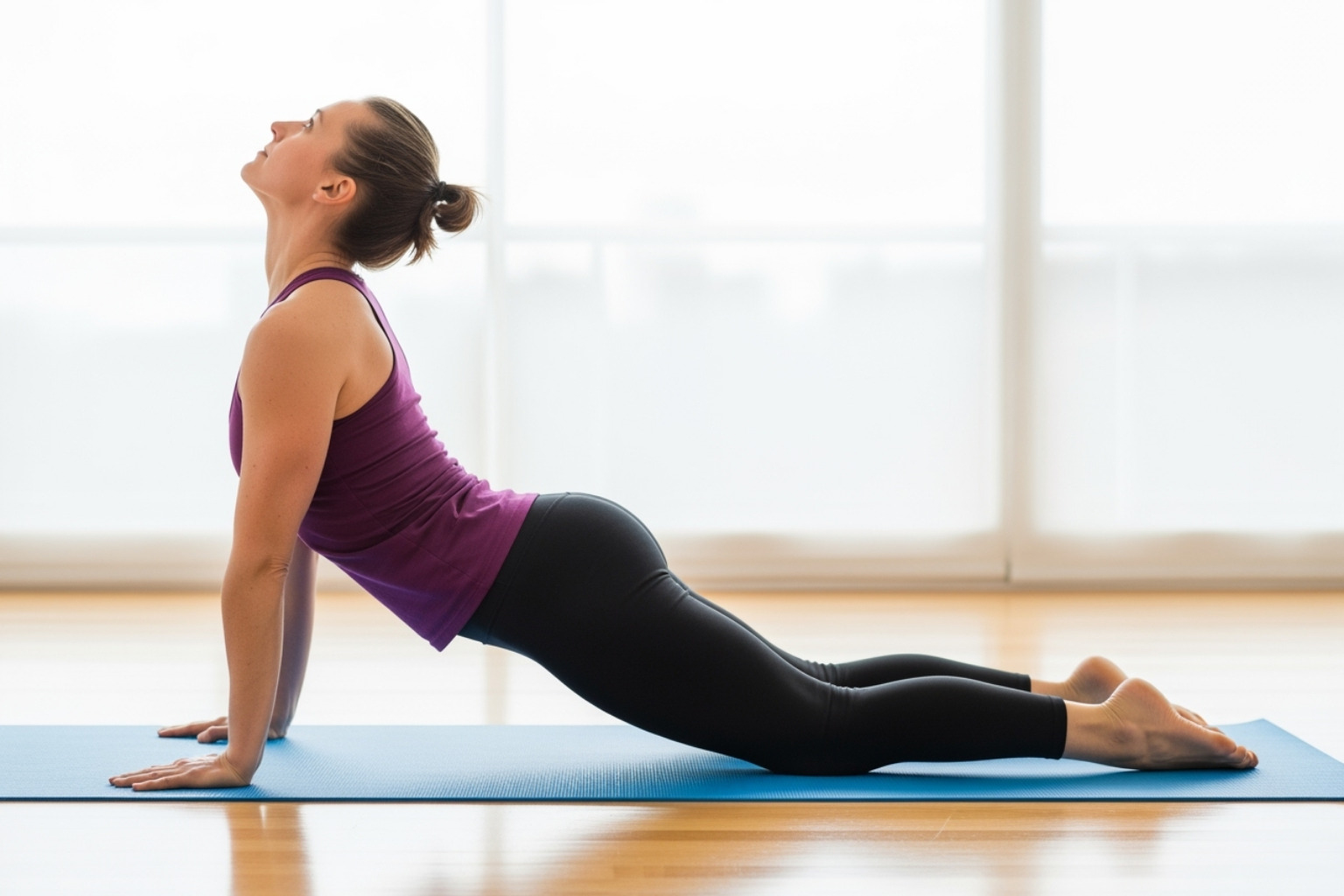Why Learning How to Stretch Traps Can Transform Your Day
How to stretch traps effectively involves gentle, targeted movements that release tension in the large trapezius muscles spanning your neck, shoulders, and upper back. Here's your quick-start guide:
Quick Relief Stretches:
- Ear-to-Shoulder Stretch - Gently tilt your head sideways, bringing your ear toward your shoulder. Hold for 20-30 seconds each side.
- Across-Body Arm Stretch - Pull one arm across your chest to stretch the shoulder blade area. Hold for 20-30 seconds.
- Shoulder Rolls - Roll your shoulders backward and forward 10-15 times to loosen tight muscles.
- Cat-Cow Pose - Move between arching and rounding your back on all fours, 10-15 repetitions.
- Child's Pose - Kneel and reach your arms forward, stretching the entire back for 20-30 seconds.
If you've ever felt a nagging weight on your shoulders, a constant ache in your upper back, or stiffness in your neck, you know what tight trapezius muscles feel like. These symptoms, along with tension headaches, often point to your traps as the culprit.
For fast, localized comfort while you work on mobility, pair these moves with a fast-absorbing muscle pain relief cream. If your discomfort includes burning, tingling, or radiating sensations, a targeted nerve pain relief cream can help calm irritated nerves while you loosen tight traps.
Poor posture from hunching over devices, chronic stress, and repetitive overhead movements can turn your trapezius muscles into tight, painful knots. The good news is that simple, targeted stretches offer immediate relief and prevent tension buildup.
Whether you're an athlete with post-workout soreness, a desk worker battling "tech neck," or someone managing chronic muscle pain, learning how to properly stretch your traps is a valuable self-care skill.
I'm Tony Enrico from Neuropasil. After years of working with athletes and chronic pain sufferers, I've seen how learning how to stretch traps correctly can be transformative. Our mission is to help you reclaim mobility and comfort, one stretch—and one jar of Neuropasil muscle pain relief cream—at a time.

Understanding Your Trapezius: Why It Aches and How Stretching Helps
Your trapezius muscle is a stress barometer for your upper body. This large, powerful muscle is constantly at work, supporting your movements. When it functions well, you barely notice it. But when it tightens, you'll feel it from your neck to your mid-back, and learning how to stretch traps becomes essential.
Anatomy 101: Meet Your Upper, Middle, and Lower Traps
The trapezius forms a trapezoid shape across your upper back, stretching from the base of your skull, across both shoulders, and down to your mid-back. It's divided into three sections, each with a specific job:
Your upper trapezius runs from the base of your skull to your shoulder blades. It helps you shrug, reach overhead, and move your head. This is often the first area to tighten under stress, pulling your shoulders toward your ears.
The middle trapezius sits between your shoulder blades. Its main job is pulling your shoulder blades together, which is crucial for good posture and provides stability for arm movements.
Your lower trapezius extends toward your mid-back. It helps pull your shoulder blades downward and plays a vital role in maintaining good posture, preventing the forward head position common with screen time.
These three sections work as a team to move and stabilize your upper body, supporting your spine and maintaining proper alignment in your neck and upper back.
The Real Reasons Your Traps Are So Tight
If you're dealing with tight traps, you're not alone. Understanding the cause is the first step toward relief.
Poor posture is a primary villain. Hunching over phones and slouching at desks forces the upper trapezius to work overtime, leading to stiffness and pain. This phenomenon, often called "tech neck," is a real condition affecting millions.
Stress and tension are equally powerful contributors. When you're anxious, your body carries that stress in your shoulders. Scientific research on stress and muscle activity confirms that trapezius muscle activity increases during stressful situations.
Previous injuries or trauma like whiplash or sports injuries can cause the trapezius muscles to tighten protectively, and they sometimes forget to relax even after healing.
Muscle imbalances develop when some muscles are stronger than others. If your chest or lower trap muscles are weak, your upper traps try to pick up the slack, leading to overwork and strain.
Repetitive movements also take their toll. Constantly reaching overhead, carrying a heavy bag on one shoulder, or even sleeping in an awkward position can strain these muscles over time.
When your trapezius muscles are tight, they limit mobility and create discomfort. For more information on managing this, explore our articles on Shoulder Muscle Pain and Muscle Tension.
The Life-Changing Benefits of Releasing Tight Traps
Learning how to stretch traps effectively can genuinely transform your daily comfort. The benefits ripple through your entire upper body.
Increased neck mobility is often the first benefit. You'll be able to check your blind spot or look over your shoulder without that familiar grinding sensation, making daily activities feel effortless again.
Improved posture follows naturally. As these muscles release their grip, your shoulders can settle into their natural, relaxed position, allowing your upper body to align properly.
The ripple effects continue with reduced tension headaches. Many headaches originating at the base of your skull are actually linked to tightness in the trapezius muscles. Release the tension, and the headaches often disappear.
You'll also experience better injury prevention. Flexible, balanced muscles absorb stress more effectively than tight ones, making them less likely to strain or tear during physical activities.
Regular stretching combined with strengthening creates a powerful one-two punch against trapezius pain, providing lasting relief. For comprehensive strategies, check out The Most Effective Solution for Neck and Shoulder Pain.
If you want fast, targeted help during flare-ups, many readers pair these habits with a high-quality muscle pain relief cream for localized soreness. If your symptoms feel nerve-related—think burning, tingling, or radiating discomfort—a specialized nerve pain relief cream can complement your stretching routine for more complete relief.
How to Stretch Traps: 7 Simple Moves for Instant Relief
Now that we understand the "why," let's dive into the "how." These tried-and-true stretches have helped countless people find relief from tight, achy traps. Each movement targets different parts of your trapezius, giving you a complete toolkit for releasing tension.
The beauty of learning how to stretch traps is that these movements are simple enough to do anywhere—at your desk, in the morning, or in the evening. You don't need any equipment, just a few minutes and a commitment to being gentle with your body.
For all static stretches, aim to hold each position for 20-30 seconds and repeat 2-3 times per side. This gives your muscles time to release. Breathe deeply throughout each stretch, as your breath is a powerful tool for relaxation. If you hold your breath, you might be pushing too hard.
Stretching should never be painful. You should feel a gentle pull, but sharp pain is your body's way of saying "back off." If you're dealing with a trapezius strain, these stretches can be a great starting point. For more comprehensive solutions, explore our guide on Trapezius Strain Treatment.
1. Ear-to-Shoulder Stretch (Upper Traps)

This is a simple, effective go-to stretch for upper traps that feel bunched up around your ears. You can do it almost anywhere.
Start by sitting or standing tall with good posture. Gently tilt your head to one side, bringing your ear toward your shoulder. You should feel a stretch along the opposite side of your neck and shoulder.
To deepen the stretch, you can place the hand from the same side on your head and apply gentle pressure. Ensure your opposite shoulder stays relaxed and doesn't creep up toward your ear.
Hold this position for 20-30 seconds, breathing steadily, then repeat 2-3 times per side.
2. Across-Body Arm Stretch (Middle Traps)

This stretch targets the area between your shoulder blades, opening up the middle trapezius and the back of your shoulder. It's great for tension caused by desk work.
Begin by standing or sitting with a straight spine. Extend one arm straight out, parallel to the floor. Use your other hand to gently pull the extended arm across your chest, supporting it just above the elbow. You should feel a stretch in your shoulder blade area.
The key is to keep your shoulders down and relaxed. Try to keep your torso facing forward rather than rotating with the stretch.
Hold for 20-30 seconds while breathing deeply, then repeat 2-3 times per side.
3. Cat-Cow Pose (Full Trapezius & Spine)

This dynamic yoga movement acts like a mini-massage for your spine and trapezius muscles. The flowing motion mobilizes your back and gently stretches your traps.
Start on all fours with your hands under your shoulders and knees under your hips.
For Cow Pose, inhale as you arch your back, dropping your belly and lifting your chest and tailbone. For Cat Pose, exhale as you round your spine, tucking your chin to your chest and letting your head hang. Focus on the area between your shoulder blades to feel the stretch in your trapezius.
Flow smoothly between Cat and Cow for 10-15 repetitions, letting your breath guide the movement.
4. Thread the Needle Pose (Middle Traps & Shoulders)
This yoga-inspired stretch offers a deeper release for your middle trapezius and the muscles around your shoulder blade.
Begin on all fours. On an exhale, slide your right arm underneath your left, palm facing up, until your right shoulder and the side of your head rest on the floor. You can press your left hand into the floor for support or extend it forward to deepen the stretch.
You should feel a stretch across your upper back and shoulder. Let gravity do most of the work.
Hold this position for 20-30 seconds, breathing into the stretch, then repeat 2-3 times per side. It's normal for one side to feel tighter than the other.
5. Child's Pose with Side Reach (Lower & Middle Traps)
This variation of Child's Pose adds a side stretch that targets the lower and middle trap fibers.
Start by kneeling, sitting your hips back toward your heels, and extending your arms forward into a standard Child's Pose. Once comfortable, slowly walk both hands over to one side, keeping your hips centered. You'll feel a stretch along the opposite side of your torso and back.
Hold this side stretch for 20-30 seconds, then walk your hands through the center to the other side. Repeat 2-3 times per side.
6. Chin Tucks (Postural Relief for Upper Traps)
This simple exercise is incredibly powerful for improving neck posture and relieving strain on your upper traps, especially if you spend a lot of time at a screen.
Sit or stand tall, looking straight ahead. Gently pull your chin straight back, creating a double chin. You should feel the back of your neck lengthen as your ears align over your shoulders. Keep your gaze level.
This movement counteracts forward head posture. Hold each chin tuck for 10 seconds, then release. Repeat 10 times, focusing on quality.
7. Shoulder Rolls (Dynamic Warm-up)
Shoulder rolls are a fantastic way to warm up your trapezius muscles and increase blood flow. They feel great after sitting still for too long.
Sit or stand tall with your arms relaxed. For forward rolls, shrug your shoulders up, then roll them forward and down. For backward rolls, shrug up, then roll them backward and down, gently squeezing your shoulder blades together.
Backward rolls are especially beneficial for reinforcing good posture. Perform 10-15 repetitions in each direction, moving slowly.
Consistency with these stretches will truly transform your relationship with your traps. Try to incorporate a few into your daily routine.
Building a Complete Trap Relief Routine
Learning how to stretch traps is a fantastic start, but for truly lasting relief and prevention, we need a more holistic approach. Think of it this way: stretching alone is like tuning just one string on a guitar—you need all the elements working together to create harmony. Incorporating these stretches into a consistent routine, combining them with other therapeutic tools, and understanding safety precautions will lead to a happier, healthier back. For those dealing with more severe issues like a torn trapezius, professional guidance is crucial, and you can find more information on Torn Trapezius Muscle Treatment: Fast-Acting Relief and Recovery Tips with Neuropasil.
How to Incorporate Trap Stretches into Your Daily Life
Here's the truth: consistency beats intensity every single time when it comes to muscle relief. Rather than one marathon stretching session that you'll dread (and probably skip), we recommend weaving trap stretches throughout your day like little gifts to your body. Think of them as "movement snacks" for your muscles!
Starting your morning with a few gentle shoulder rolls, ear-to-shoulder stretches, and cat-cow poses is like pressing the reset button on your trapezius. This wakes up your muscles and sets a positive tone for your posture throughout the entire day. I like to do mine while my coffee brews—it's amazing how much better you feel when you begin the day with intentional movement.
If you have a sedentary job, those desk breaks become absolutely crucial. Every 30-60 minutes, take a quick movement snack: a chin tuck here, a few shoulder shrugs there, or an ear-to-shoulder stretch while you're thinking through that email. Set a timer on your phone as a reminder—your future self will thank you! These micro-breaks prevent tension from building up in the first place, which is far easier than trying to undo eight hours of hunching.
Your evening wind-down is the perfect time for a more relaxed sequence. Before bed, incorporate stretches like Thread the Needle or Child's Pose with a side reach. This helps release the day's accumulated tension and prepares your body for truly restorative sleep. And if you're working out, always dedicate time post-workout to static trap stretches—they aid muscle recovery and maintain the flexibility you've worked so hard to build.
By making these stretches a regular part of your routine, you're actively working to prevent tightness rather than constantly chasing relief. It's the difference between being proactive and reactive with your body.
Beyond the Stretch: Tools and Strengthening Exercises
While stretching is vital, it's just one piece of the puzzle. For comprehensive relief and long-term prevention of Muscle Pain, we often need to combine stretching with other methods. Here's how different approaches work together:
Massage tools like foam rollers and massage balls can work wonders for releasing those stubborn knots in your traps. A lacrosse ball pressed against a trigger point while you lean against a wall can provide targeted relief that your hands simply can't reach. Foam rolling along your upper back before stretching helps warm up the tissue and makes your stretches more effective.
Heat therapy is another game-changer. Applying a warm compress or heating pad to tight traps for 15-20 minutes helps relax the muscle fibers, making them more receptive to stretching. Many people find that combining heat with gentle stretching provides significantly better relief than either method alone.
Topical creams and patches (fast, targeted relief) can be a smart add-on. A high-quality muscle pain relief cream can provide on-the-spot comfort for sore, overworked traps. If your symptoms include burning, tingling, or radiating pain, consider a nerve pain relief cream; products with proven topicals like menthol, capsaicin, or lidocaine are commonly used for localized muscle and nerve-related discomfort. Apply a thin layer as directed (often 3–4 times daily), massage it in after heat and before static stretching, and patch-test if you have sensitive skin. Evidence overviews support the use of select topical analgesics for acute and chronic pain, and capsaicin/lidocaine options are frequently used for nerve-related symptoms.
But here's something crucial that often gets overlooked: strengthening exercises are just as important as stretching, maybe even more so. While stretching improves flexibility and provides immediate relief from tightness, strengthening the middle and lower traps corrects the muscular imbalances that caused the problem in the first place. Exercises like rows (pulling your elbows back while squeezing your shoulder blades together) and Y-raises (lifting your arms overhead in a Y-shape while lying face-down) specifically target these often-neglected areas.
When your middle and lower traps are strong, they can properly support your shoulder blades and take pressure off your overworked upper traps. This prevents the tightness from returning and improves your overall posture. Think of it as addressing the root cause rather than just treating symptoms.
The sweet spot? Combine all three approaches—stretch for immediate relief and flexibility, strengthen to prevent future problems, and use massage tools, heat, and the right topical support to improve both.
How to Stretch Traps Safely: Tips and Precautions
Now, let's talk about staying safe while you stretch. Your body is remarkably good at communicating with you—the trick is learning to listen. The golden rule when learning how to stretch traps is this: stretching should feel like a gentle pull, never sharp pain. If you feel any shooting, stabbing, or intense pain, ease back immediately. You're looking for that "hurts so good" sensation, not genuine discomfort.
Gentle movements are your best friend here. There's no prize for pushing into the deepest stretch possible right away. Your muscles need time to relax and lengthen. Ease into each position slowly, breathe deeply, and let your body gradually release the tension. Forcing a stretch often triggers your muscles to tighten up as a protective response—the exact opposite of what you want.
Pay attention to your breathing throughout each stretch. Holding your breath creates tension, while deep, steady breathing helps your nervous system relax and your muscles release. Inhale through your nose, exhale through your mouth, and imagine breathing directly into the tight area.
There are times when you should avoid stretching altogether or seek professional guidance first. If you have an acute injury (something that just happened and is causing significant pain), wait until the initial inflammation subsides before stretching. Sharp, localized pain, numbness, tingling down your arms, or severe weakness are all signs you should see a doctor before attempting these stretches. According to Harvard Health on stretching safety, proper stretching technique and knowing when not to stretch are just as important as the stretches themselves.
If you're dealing with chronic pain that doesn't improve with gentle stretching, or if your symptoms worsen, it's time to consult a healthcare provider. They can rule out underlying conditions and provide personalized guidance. These stretches are designed for general tightness and tension—they're not a substitute for medical treatment when something more serious is going on.
The most important thing? Listen to your body. It's smarter than any article or expert advice. If something doesn't feel right, don't do it. There are seven stretches in this guide for a reason—find the ones that work best for your body and make those your go-to moves.
References
- NIH/PMC: Stress increases trapezius muscle activity (electromyography evidence). https://www.ncbi.nlm.nih.gov/pmc/articles/PMC5265893/
- Harvard Health Publishing. The importance of stretching. https://www.health.harvard.edu/staying-healthy/the-importance-of-stretching
- Derry S, Wiffen PJ, Kalso EA, Moore RA. Topical analgesics for acute and chronic pain in adults—an overview of Cochrane Reviews. Cochrane Database of Systematic Reviews; 2017. Open-access summary via NIH/PMC: https://www.ncbi.nlm.nih.gov/pmc/articles/PMC6494257/
- Derry S, Rice ASC, Cole P, Tan T, Moore RA. Topical capsaicin (high concentration) for chronic neuropathic pain in adults. Cochrane Review summary: https://www.cochrane.org/CD007393/SYMPT_topical-capsaicin-high-concentration-8-patch-treatment-chronic-neuropathic-pain-adults
- Physio-pedia. Upper Trapezius. https://www.physio-pedia.com/Upper_Trapezius













